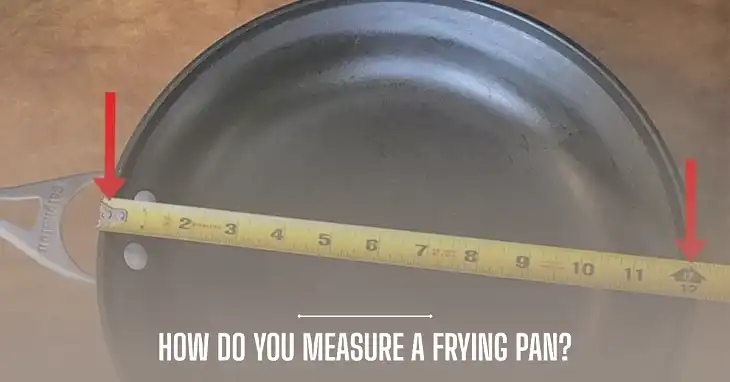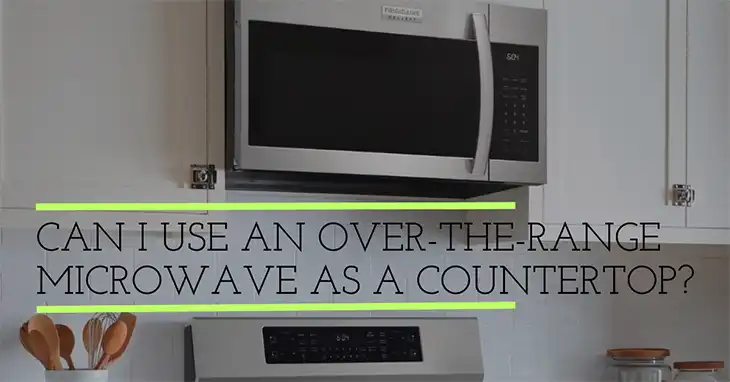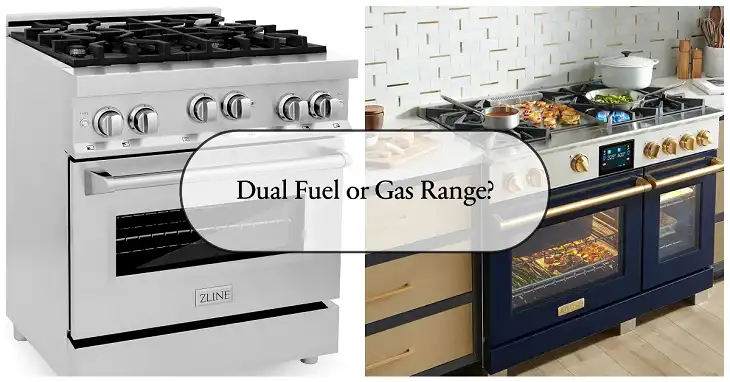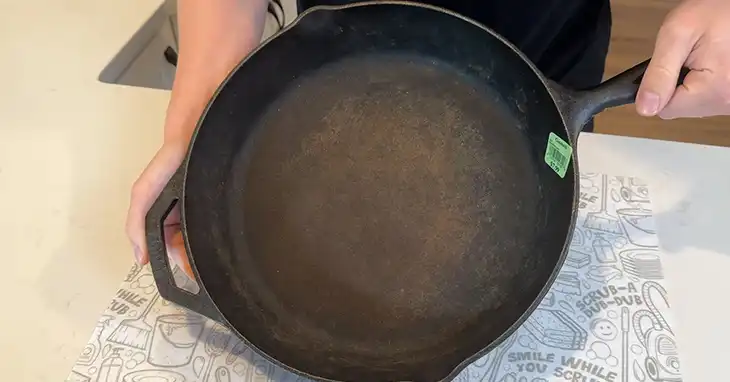How Do You Measure a Frying Pan? [Answered]

To measure a frying pan, place a measuring tape or ruler across the top rim from one side to the other, noting the diameter in inches. The most common measurement used to categorize frying pans is their diameter, which typically ranges from 8 to 14 inches. Understanding these dimensions ensures that you use the right pan size for your recipes, and ensures proper cooking results.
This article will walk you through not only the method to measure a frying pan accurately but also why these measurements matter, how they affect cooking performance, and what you should keep in mind when selecting a pan for your kitchen. We’ll also cover the significance of the pan’s cooking surface, depth, and stovetop compatibility as well.
How to Measure a Frying Pan?
The primary measurement for any frying pan is its diameter, measured in inches. To get this measurement, place the frying pan on a flat surface with the cooking side up. Use a measuring tape or a ruler and position it horizontally across the top rim from one edge to the opposite side. The measurement should be taken across the widest point of the pan, disregarding the curve of the sides or the base, as this gives a more accurate reflection of the pan’s overall size.
Tip: Although there are many different types of specialty pans, a frying pan and a skillet are the same thing. The distinction lies mainly in the language origin: the word “skillet” comes from Old French, while “pan” has its roots in Old English. In modern kitchens, the terms are used interchangeably. So whether a recipe calls for a skillet or a frying pan, you can confidently use either one without worry.
For example, if the tape shows 10 inches from rim to rim, you have a 10-inch frying pan. Most frying pans fall into the following standard sizes:
| Pan Size | Use |
| 8 inches | Small portions, omelets, or individual meals. |
| 10 inches | Versatile for most recipes, fits standard stovetops. |
| 12 inches | Larger meals, searing steaks, or cooking for multiple people. |
| 14 inches | Large batches, stir-fries, or family-style cooking. |
When measuring, always avoid including the handles or flared edges, as these parts do not contribute to the actual cooking area. The diameter should reflect the flat cooking surface’s usable space.
Measuring the Cooking Surface Area
While the diameter is the standard way to classify frying pans, the effective cooking surface area is often smaller, especially for pans with curved sides. To measure the cooking surface, start at the flat base of the pan where the side walls begin to rise. This dimension is crucial for determining how much food can be placed on the pan at once without overcrowding.

For example, a 10-inch frying pan might only have an 8-inch cooking surface, depending on the slant of its walls. This means less space to sear meats or cook large items evenly. Understanding this difference helps you choose the right pan for specific cooking techniques, like stir-frying or simmering.
Why Proper Frying Pan Measurement is Important?
The size of your frying pan affects everything from heat distribution and cooking efficiency to the final texture of your food. A pan’s dimensions should be aligned with the type of cooking you want to do, the portion size, and your stovetop’s burner size.
Heat Distribution and Cooking Efficiency
Pans with larger diameters distribute heat over a broader area. For instance, a 12-inch pan will have a much larger cooking surface compared to an 8-inch pan, which means more space for food but potentially less heat concentration. If your stove has a small burner, a larger pan can result in uneven heating, where the center cooks faster than the outer edges.

Choosing a pan that matches your burner size will ensure even cooking and prevent hot spots or cold spots. For a typical home stove, a 10-inch or 12-inch pan is optimal. If you often cook on a smaller burner, consider an 8-inch or 9-inch pan for more consistent results.
Compatibility with Recipes and Cooking Techniques
Recipes often specify pan sizes for a reason. Using the right-sized pan helps maintain the correct cooking temperatures and prevents ingredients from crowding. For example, using a small pan for sautéing too many vegetables at once can result in steaming instead of browning. Conversely, using a pan that’s too large can lead to food spreading out too thinly, cooking too quickly, and burning.
Additionally, certain cooking techniques, like searing meat, require sufficient space around each piece to achieve a crispy exterior. A 12-inch pan is ideal for searing multiple pieces of meat without overlapping, while an 8-inch pan might only fit one or two small portions.
Practical Tips for Pan Selection
- Match the Pan to Your Burner Size: An 8-inch pan is suitable for a 6-inch burner, while a 12-inch pan fits well on an 8-inch burner. This ensures proper heat coverage across the pan’s surface.
- Select the Pan Size Based on Cooking Needs: If you cook for a family, opt for a 12-inch pan. For single servings, stick to 8 or 10 inches.
- Consider the Pan’s Weight and Handle: Larger pans, especially those made of cast iron, can be heavy. A long, ergonomic handle provides better control when flipping or stirring.
Is it Necessary to Measure Pan Depth?
Depth is another often overlooked aspect of a frying pan. Shallow pans, typically 1.5 to 2 inches deep, are excellent for high-heat cooking, where quick evaporation is desired. Deeper pans, ranging from 2.5 to 3.5 inches, are more versatile for cooking with liquids, such as simmering sauces, braising, or shallow frying.
To measure the depth, place a ruler vertically at the pan’s interior bottom and extend it straight up to the top rim. Avoid measuring at an angle, as this will distort the reading.

Recommended Depths for Different Cooking Styles
- 1.5 to 2 inches: Ideal for quick frying, sautéing, or making crepes.
- 2.5 to 3 inches: Suitable for simmering, making reductions, or frying with minimal oil.
- 3.5 inches and above: Best for braising, shallow frying, or cooking large volumes of food.
The depth affects the pan’s capacity and ability to retain moisture. A shallower pan is better for dry-heat methods, while a deeper pan provides more versatility.
Frying Pan Sizes and Stovetop Compatibility
When choosing a frying pan, compatibility with your stovetop is essential. Electric stoves and induction cooktops, for example, require flat-bottomed pans that maintain full contact with the burner surface. For gas stoves, the flame should not extend beyond the pan’s edges.
| Burner Diameter | Ideal Pan Size |
| 5 inches | 6 to 8-inch frying pan |
| 7 inches | 9 to 10-inch frying pan |
| 9 inches | 11 to 12-inch frying pan |
| 11 inches | 13-inch and above |
Ensuring your pan size aligns with the burner helps avoid uneven cooking and energy waste. A pan too large for a small burner will leave the outer edges undercooked, while a small pan on a large burner will overheat, causing food to scorch.
Which Frying Pan Size is Appropriate for You
Let’s say you have a recipe calling for sautéing onions and peppers for a stir-fry. A 12-inch pan would be ideal as it provides ample space for the vegetables to spread out, allowing even caramelization without crowding. However, if you only have a 10-inch pan, you can cook the vegetables in batches to achieve similar results.
On the other hand, if you’re frying an egg, a smaller 8-inch pan is preferable because it prevents the egg from spreading too thinly, making it easier to flip and control.
FAQs
Can I measure a pan with sloped sides the same way?
Yes, measure across the top rim from edge to edge. Ignore the sloped walls as they do not affect the diameter measurement.
Do manufacturers measure pans differently?
Most manufacturers use the top diameter, but always double-check if you’re unsure. Some may list the base or cooking surface area separately.
How do I find a fitting lid for my pan?
Match the lid size to the pan’s top diameter. If your pan is 10 inches, look for a 10-inch lid.
Can I use a larger pan on a small burner?
Yes, but be mindful that heat distribution will be uneven, causing inconsistent cooking results.
Why is the frying pan base smaller than the top?
Frying pans are often designed this way for better heat retention and to prevent food from spilling over.




